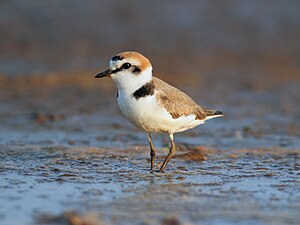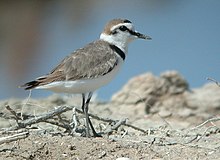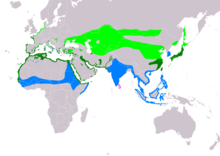Kentish plover
| Kentish plover | ||||||||
|---|---|---|---|---|---|---|---|---|

Kentish plover Charadrius alexandrinus alexandrinus |
||||||||
| Systematics | ||||||||
|
||||||||
| Scientific name | ||||||||
| Charadrius alexandrinus | ||||||||
| Linnaeus , 1758 |
The Kentish plover ( Charadrius alexandrinus ) is a species of bird from the family of Plover (Charadriidae). It is a breeding bird of the steppe and coastal areas of Europe and Asia as well as North, South and Central America. In Central Europe it occurs as a breeding bird only in the coastal areas. Even as a migrant, he is rarely seen inland.
description
A fully grown Kentish plover becomes 15 to 20 cm tall and has a wingspan of 35 to 45 cm. It weighs 30 to 55 g. The medium-length legs are dark and the short beak is colored black, as are the eyes. The top of the Kentish plover is brown-gray and the underside is colored white. Dark streaks can be seen on the sides of the neck. The Kentish Plover also has a dark streak of eyes. In the summer the crown and the neck of the male are colored russet. The white wing band can only be clearly seen in flight. His call sounds like "bip" or "drip".
habitat
The breeding area of the Kentish plover includes coastal and steppe regions of Eurasia from Cape Verde to Japan. It also occurs in North Africa to about Somalia, in parts of South Asia and the west and south of North America, parts of Central America and the west coast of South America. In the old world three subspecies are represented: the nominate form Charadrius alexandriunus alexandrinus , which in Central Europe breeds almost exclusively in the area of the North Sea, has a distribution area that includes the north of Africa across Europe to the east of the Palearctic . The subspecies C. a. dealbatus occurs in eastern China and Japan and the subspecies seebohmi is native to Sri Lanka and the southeast.
Breeding birds in the south are resident birds , while the Kentish plover, common to the north, are migratory birds . Their winter quarters extend from the Mediterranean, for example, from Valencia via Sardinia, southern Italy and the southern coast of Turkey to the Gulf of Guinea, Somalia and the Persian Gulf. Wintering quarters can also be found in southern Asia. In the Wadden Sea of Central Europe, Kentish plovers are most common from August to September.
Wetlands International names a large number of important resting places and wintering quarters for the Kentish plover, many particularly important ones are in the north of Egypt, but are threatened by urbanization and drainage ; Lake Manzala in northeastern Egypt and Wadi el-Natrun are considered significant . Other important resting places are the Camargue , the Banc d'Arguin , the coastal region of Benghazi , the estuary of the Rio Miño , the Rhine-Meuse delta , the estuary of the Ebro and the wetlands to the west of Almería .
nutrition
The Kentish plover's menu includes worms , snails , insects , larvae and crustaceans . It runs very quickly in the typical rainplover manner and then stops abruptly inside. It also frequently tramples its feet very quickly to lure prey to the surface. He also pokes for food in damp silt and sand.
Reproduction
The Kentish plover becomes sexually mature after one year of life. The breeding season extends from May to July. Every year they return to the same nesting site whenever possible, perhaps to complete a relatively long (5 to 10 minute) mating act with the same partner. The nest is a hollow on the ground that is lined with parts of plants and other materials. The female lays three eggs in five days . The eggs weigh 10 g each and are well camouflaged by their color pattern. After four weeks of breeding, the young birds hatch and immediately start exploring the area. If danger threatens, the parents try to attack the animal or lead it in the wrong direction.
Duration
The IUCN put the total population at 300,000 to 460,000 animals in 2012 and therefore classified the species as least concern (not endangered). The total European population was estimated at 22,000 to 35,000 breeding pairs at the beginning of the 21st century. In 1991 only 569 breeding pairs were counted in the international Wadden Sea , in Germany only 182 breeding pairs in 2005, with a rapidly decreasing trend.
In Lower Saxony the population decreased from 400 breeding pairs to 80 breeding pairs by the turn of the century since the 1950s. Disturbances by tourists on the beaches are given as the reason for the population decline in Germany.
The species is listed in the Red List of Endangered Breeding Birds in Germany in Category 1 (threatened with extinction) and is listed in Appendix I of the EU Birds Directive .
The Kentish plover is one of the species that is forecast to benefit from global warming . A research team that, on behalf of the British Environmental Protection Agency and the Royal Society for the Protection of Birds, examined the future development of the distribution of European breeding birds on the basis of climate models, assumes that the potential habitat of the Kentish plover will be in Europe by the end of the 21st century significantly expanded. According to this forecast, the distribution areas in the region around the Black Sea, on the Mediterranean and on the Atlantic coast of Europe will increase. Potential new habitats for this species can also be found in western Great Britain and Ireland. However , the distribution on the Central European coasts will decrease.
supporting documents
literature
- Hans-Günther Bauer, Einhard Bezzel and Wolfgang Fiedler (eds.): The compendium of birds in Central Europe: Everything about biology, endangerment and protection. Volume 1: Nonpasseriformes - non-sparrow birds. Aula-Verlag Wiebelsheim, Wiesbaden 2005, ISBN 3-89104-647-2 .
- Einhard Bezzel: birds. BLV Verlagsgesellschaft, Munich 1996, ISBN 3-405-14736-0
- Peter Colston , Philip Burton: Limicolen - All European wader species, identifiers, flight images, biology, distribution. BlV Verlagsgesellschaft, Munich 1989, ISBN 3-405-13647-4
- Simon Delany, Derek Scott, Tim Dodman, David Stroud (Eds.): An Atlas of Wader Populations in Africa and Western Eurasia. Wetlands International , Wageningen 2009, ISBN 978-90-5882-047-1 .
Web links
- Charadrius alexandrinus in the endangered Red List species the IUCN 2012. Posted by: BirdLife International, 2012. Retrieved on July 6, 2014.
- Videos, photos and sound recordings of Charadrius alexandrinus in the Internet Bird Collection
- Age and gender characteristics (PDF; 2.2 MB) by J. Blasco-Zumeta and G.-M. Heinze (Eng.)
- Videos on Charadrius alexandrinus published by the Institute for Scientific Film .
Individual evidence
- ↑ Bezzel, p. 233
- ↑ Bauer et al., P. 449
- ↑ Bauer et al., P. 449
- ↑ Delany et al., P. 233
- ↑ Delany et al., Pp. 233-235.
- ↑ Colston et al., P. 49
- ↑ The inventory data is from Wetlands International from 2006.
- ^ Wilhelm Breuer: Regenpfeifer - The end of the song . National Park No. 157 (3/2012): 25-27.
- ↑ Christoph Grüneberg, Hans-Günther Bauer, Heiko Haupt, Ommo Hüppop, Torsten Ryslavy, Peter Südbeck: Red List of Germany's Breeding Birds , 5 version . In: German Council for Bird Protection (Hrsg.): Reports on bird protection . tape 52 , November 30, 2015.
- ^ Brian Huntley, Rhys E. Green, Yvonne C. Collingham, Stephen G. Willis: A Climatic Atlas of European Breeding Birds , Durham University, The RSPB and Lynx Editions, Barcelona 2007, ISBN 978-84-96553-14-9 , P. 172



